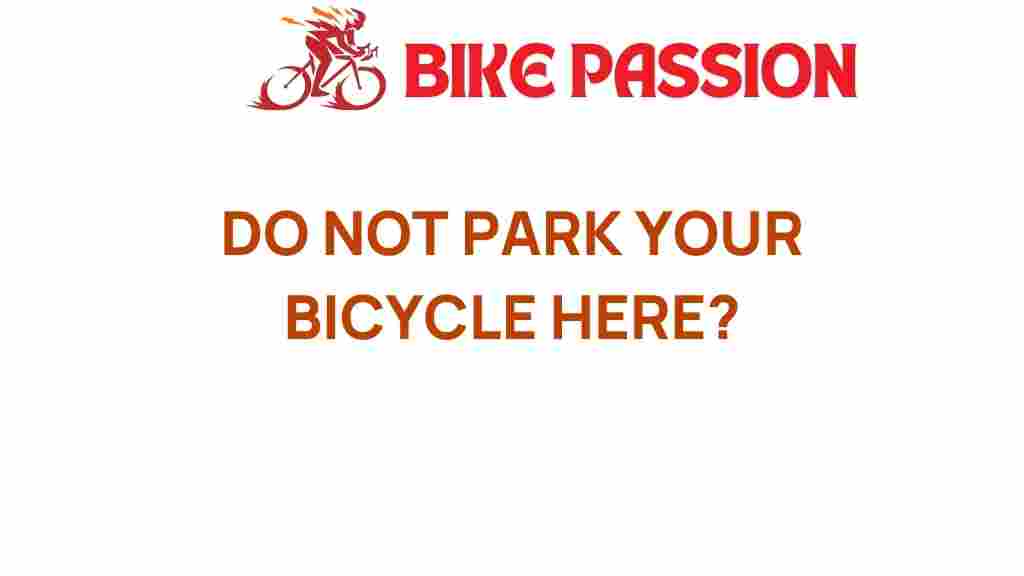Bicycle Parking: The Do’s and Don’ts for Urban Cyclists
Urban cycling is becoming increasingly popular as people seek sustainable transportation options. However, with this rise in cycling comes the pressing issue of where to park your bicycle safely. In this article, we will unravel the mystery of why you should never park your bicycle in certain locations and provide invaluable tips on bike safety, parking regulations, and city infrastructure. If you’re a commuter or an urban cyclist, this guide is tailored for you!
Understanding Bicycle Parking Regulations
The first step to ensuring your bike’s safety is to understand the parking regulations in your city. Most urban areas have specific rules regarding bicycle parking to maintain order and safety. Here are some common regulations you should be aware of:
- Designated Bike Racks: Always look for official bike racks. Parking your bike in these areas not only ensures its safety but also complies with local regulations.
- No Parking Zones: Avoid parking your bicycle in no-parking zones, which can lead to fines or your bike being removed.
- Sidewalk Restrictions: Some cities have restrictions on parking bicycles on sidewalks, especially in busy areas.
- Private Property: Always seek permission before parking on private property to avoid potential removal.
Why You Should Avoid Certain Parking Spots
Now, let’s delve into the reasons why you should never park your bicycle in specific locations:
- Near Heavy Traffic: Parking your bicycle too close to the road can increase the risk of theft or damage from passing vehicles.
- Unmonitored Areas: Avoid parking in dark or isolated spots, which are breeding grounds for theft.
- Obstructing Pathways: Parking in a way that blocks pedestrian traffic can lead to fines and potential accidents.
- Prohibited Zones: As mentioned earlier, always steer clear of restricted areas to prevent fines and bike impoundment.
Step-by-Step Guide to Safe Bicycle Parking
To ensure your bicycle remains safe while you’re away, follow this step-by-step guide:
- Plan Ahead: Before you head out, research available bicycle parking options at your destination. Many cities have apps or websites that map out bike racks and parking zones.
- Use a Quality Lock: Invest in a high-quality U-lock or chain lock. Always lock your frame and at least one wheel to a solid object.
- Secure Your Accessories: Remove any easily detachable items, such as lights or bags, to deter thieves.
- Park in Well-Lit Areas: Choose a location that is well-lit and has a good view from the street to deter potential thieves.
- Check Local Regulations: Always be aware of local bicycle parking rules to avoid fines and ensure your bike’s safety.
Cycling Tips for Urban Commuters
As an urban cyclist, there are several tips to enhance your cycling experience and safety:
- Wear a Helmet: Always wear a helmet to protect yourself in case of accidents.
- Be Visible: Use lights and reflective gear, especially when cycling at night.
- Follow Traffic Rules: Adhere to traffic signals and lanes designated for bicycles.
- Stay Alert: Keep an eye on your surroundings and be aware of vehicles, pedestrians, and other cyclists.
Common Bicycle Parking Mistakes and How to Avoid Them
Even seasoned cyclists can make parking mistakes. Here are some common pitfalls and how to avoid them:
- Locking Only the Wheel: Ensure you lock both the frame and one wheel to a fixed object. Thieves can easily detach a wheel if it’s the only part locked.
- Not Using Multiple Locks: For high-value bikes, consider using two different types of locks to deter thieves.
- Parking Too Close Together: Avoid clustering your bike with others, as it can make it easier for thieves to steal a bike without being noticed.
- Ignoring Local Advice: Always stay informed about local crime trends and seek advice from local cycling groups.
City Infrastructure and Its Impact on Bicycle Parking
City infrastructure plays a crucial role in supporting urban cycling. Here are some aspects to consider:
- Availability of Bike Racks: A well-planned city should have ample bike racks at key locations like transit hubs, parks, and commercial areas.
- Cycling Lanes: Dedicated cycling lanes make it safer to navigate through traffic, reducing the need to park in unsafe areas.
- Public Awareness Campaigns: Cities that promote cycling safety and awareness help create a culture that respects bike parking regulations.
Resources for Urban Cyclists
For further information on bike safety and urban cycling, consider visiting external resources such as The League of American Bicyclists. They offer a wealth of information on cycling advocacy, safety tips, and regulations.
Additionally, local cycling groups can provide insights into the best places to park your bike and share experiences with other cyclists. Participating in community events can also enhance your knowledge and safety as a cyclist.
Conclusion: Park Wisely for Maximum Bike Safety
In conclusion, understanding bicycle parking regulations and choosing the right spots to park your bike is essential for ensuring your bike’s safety in urban environments. By following the guidelines provided in this article, you can enhance your urban cycling experience and reduce the risk of theft or damage to your bicycle.
Remember, urban cycling is not just about getting from point A to point B; it’s about doing so safely and responsibly. With the right knowledge and preparation, you can enjoy the many benefits of cycling while keeping your bike secure. For more tips and advice on urban cycling, be sure to check back for our latest articles.
This article is in the category Maintenance and created by BikePassion Team
